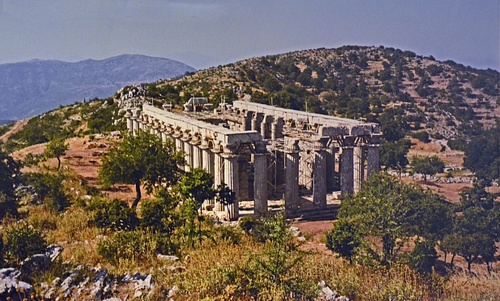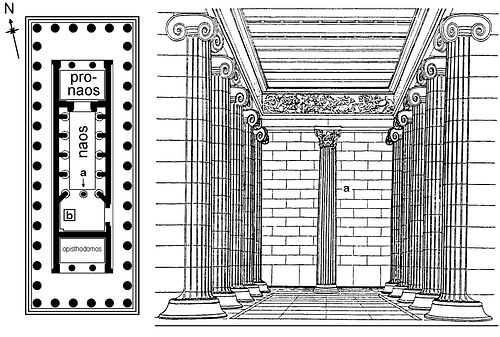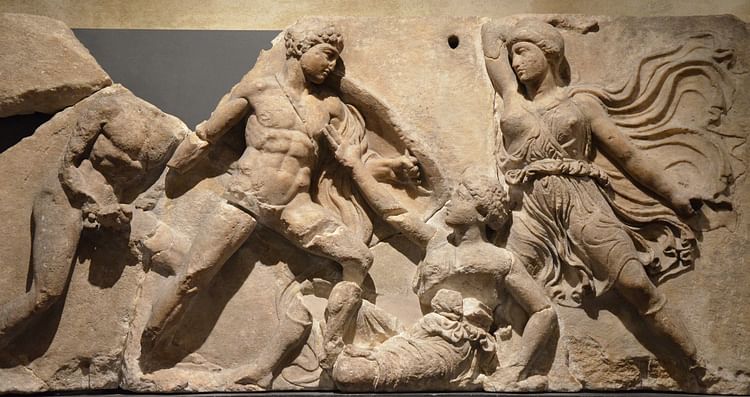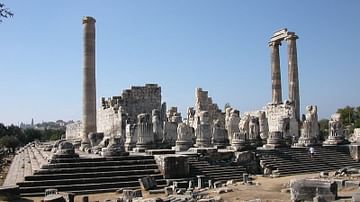
Bassae (Bassai), located in south-west Arcadia on the slopes of Mt. Kotilion, was an important temple site in the Archaic and Classical periods. Its large 5th-century BCE temple of Apollo, now covered with a permanent roof, is one of the best-preserved temples in Greece and displays important innovations in Greek architecture. Bassae is listed by UNESCO as a World Heritage Site.
Historical Overview
The name Bassae derives from the many small ravines (bassae or bissae) amongst the rocks of Mt. Kotilion. The sanctuary, which developed its own small settlement, was connected to the nearest town, Phigaleia, via a sacred way. The settlers of Bassae were also responsible for another sanctuary higher up the mountain dedicated to Artemis and Aphrodite.
The first votive offerings at the sanctuary site of Bassae date to the last quarter of the 8th century BCE. Four temples were built to Apollo, starting in the 7th century BCE and ending in the 5th century BCE, each replacing and larger than its predecessor. The sanctuary was not only dedicated to Apollo, though, as one inscribed vessel reports a cult to Aphaea, the fertility and agricultural goddess, and there was a precinct dedicated to Pan, the pastoral god. Next to the famous temple of Apollo there is a sacred building, or sekos, with two chambers and evidence of a metallurgy workshop. Finds at the site include votive offerings of fine pottery from Corinth and Laconia, ceramic figures, jewellery, a tortoise-shell lyre, and many small bronze figurines. Bassae's importance began to fade from the 4th century BCE with the founding of the Arcadian League and Megalopolis by Thebes in 371-370 BCE, which meant the site received fewer and fewer dedicatory offerings and was eventually abandoned.
The Temple of Apollo
The large temple of Bassae was dedicated to Apollo Epicurius (or 'Apollo the Helper') which may refer, not to any medicinal connotation, but to the fact that many Arcadians fought as mercenaries for Messenia against Sparta. In Greek, an epikouros was both an ally and mercenary. Certainly, the site received an unusual amount of dedicatory weapons and armour, typically made in miniature. Another epithet of Apollo, the local 'Bassitas', is found on a bronze tablet inscribed with details of a manumission.
The temple was completed, after an interruption caused by the Peloponnesian War, in the latter decades of the 5th century BCE. According to the 2nd-century CE Greek travel writer Pausanias, it was designed by Ictinus, who was also the architect of the Parthenon. There is no supporting evidence for this claim, and elements of the architecture of the temple do display a local influence. It is a unique combination of all three Classical Greek architectural orders with, for example, a Doric columned exterior, an interior Ionic decorative frieze, and a single Corinthian column and capital inside.

The temple was built on the site of an earlier, smaller version (600-570 BCE) and is, likewise, aligned to the north. Most Greek temples were constructed on an east-west axis. Consequently, there is an opening in the east wall to permit morning sunlight to enter and light the interior. The exterior had 6 columns on the facades and 15 on the long sides. Instead of a sculptural frieze, the exterior decoration is provided by alternating plain metopes and triglyphs.
Inside, the side walls of the cella have tall engaged Ionic columns (five on each side) while the adytum room (which housed the cult statue of the god) is separated from the cella by a single Corinthian column, centrally placed. The temple is the first known building to use a Corinthian capital. Another indicator of a master architect at work is the interior ceiling, which is composed of marble coffers (sunken square panels) with purposely cambered (curved) backs to increase their load-bearing strength. Unusually, there were no wooden elements to the interior ceiling, and all beams and rafters were made using stone. The roof of the temple was made with marble slabs and shows signs of later Hellenistic period repairs using terracotta.

While the exterior of the temple is rather austere, shorn as it is of any decoration, the interior has figure sculpture. This is rendered in marble while the rest of the temple is of local limestone. The slabs of the frieze, now in the British Museum in London, depict battles involving centaurs fighting Lapiths and Greeks battling Amazons. Originally there were 23 slabs creating 31 metres of frieze. The metopes of the pronaos (the interior entrance space) also carried sculpture. These depicted two mythological scenes: the Dioskouroi (Castor and Pollux) raping the daughters of Leucippus, a king of Messenia, and Apollo returning from Mt. Olympus.





